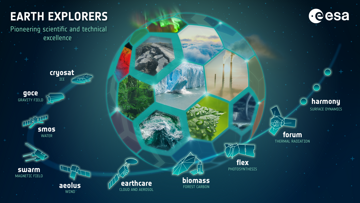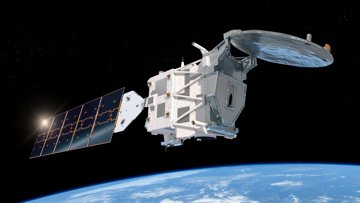EarthCARE launched with Dutch instrument for research into climate change caused by clouds and aerosols
Europe's new satellite EarthCARE was successfully launched into space today. The scientific mission investigates the influence of clouds and aerosols on climate change. Dutch companies supplied hardware, KNMI researchers are eagerly awaiting the first data.
Clouds and aerosols make
EarthCARE launch. Source: ESA
an important contribution to the warming of our planet, scientists think. But hard evidence is lacking. “It is one of the largest uncertainties in current climate models,” says Thorsten Fehr, ESA's head of atmospheric research. “And EarthCARE will reduce that uncertainty in the coming years.”
EarthCARE (Earth Cloud, Aerosol and Radiation Explorer) is the sixth mission in ESA's scientific Earth Explorer programme. It is also the most complex Earth observation satellite that ESA has ever built. On board is the MSI multi-spectral camera developed by TNO and SSTL. This must work together with a laser instrument, a radar instrument and a radiation meter; a method never before used in space.
Clouds are a blanket
Why does science attribute clouds and aerosols to such a major role in global warming? Gerd-Jan van Zadelhoff, researcher at the KNMI, knows this: 'Clouds high in the atmosphere function like a kind of blanket: they retain heat radiation from the earth. The opposite applies to low clouds: they radiate sunlight back into space and cool the Earth. All the clouds in between can either warm or cool the Earth. That depends on how many aerosols they contain, the size of water droplets and more.'
EarthCARE will use its instruments to measure the interaction between clouds, aerosols and heat radiation. Van Zadelhoff: 'For the first time we can establish a relationship between how much heat radiation reaches the Earth, which clouds and aerosols we see and how much heat radiation leaves the Earth.'
Synergy between satellites
Earth Observation Satellites. Bron: ESA
EarthCARE is not the only satellite tasked with unraveling the cloud mystery. In February, NASA launched the PACE satellite, for which the Netherlands supplied the SPEXone instrument. This satellite also examines aerosols. Yet the satellites are not competitors, says Bastiaan van Diedenhoven, senior researcher at SRON.
PACE measures averages of an entire column of particulate matter in the atmosphere. EarthCARE is able to measure the vertical distribution of particulate matter. And EarthCARE can clearly observe which clouds rain out and how snow and ice are formed, while PACE provides information about small particles in the clouds before they form rain. “Individually, the satellites can already do a lot,” says Van Diedenhoven. “But if you take the data from both together, you can do groundbreaking science and make many new discoveries.”
Dutch components
Dutch scientists have to wait until the end of 2024 before they can work with the first data from EarthCARE. For the Dutch business community, work on the mission has been finished for some time. Airbus developed and built the satellite's solar panels, Bradford Space part of the propulsion system.
Rob van Hassel from Airbus: 'When you think of many satellites, you think of a box full of instruments with solar panels on either side. EarthCARE, which has been nicknamed the “White Dragon”, has the solar panels in a very special place: the back. You could say we gave the dragon a tail.”
The panels are located at the back, because EarthCARE flies in a relatively low orbit around the earth, Van Hassel explains: 'By placing the solar panels at the back, we make the smallest possible contribution to air resistance. Moreover, the solar panels form a nice countermass for the heavy laser instrument at the front.'
Bradford Space built six pressure transducers for EarthCARE's propulsion system. They indicate how much fuel is still available for maneuvers with the satellite. The parts originally come from Formula 1. Bradford made them suitable for space travel. The company has now built more than four hundred pressure transducers. The first flew on comet hunter Rosetta in 2004. Other examples are on the ESA missions JUICE and Euclid.

EarthCARE satellite. Bron: ESA
Remaining relevant
The launch of EarthCARE has been postponed several times in recent years. The development of the laser instrument, the Covid pandemic and the war in Ukraine, among other things, caused significant delays. According to Thorsten Fehr, the fact that the mission finally got off the ground today is an absolute milestone and remains important for science.
'The need for EarthCARE data has only increased. This is an extremely important and relevant mission for the global scientific community. It will teach us a lot about the impact we humans have on the climate and significantly improve predictions about global warming in the short and longer term.'
More Information
EarthCARE
Earth Explorers programma
Airbus Nederland - EarthCARE
KNMI - EarthCARE
Bradford Space
TNO